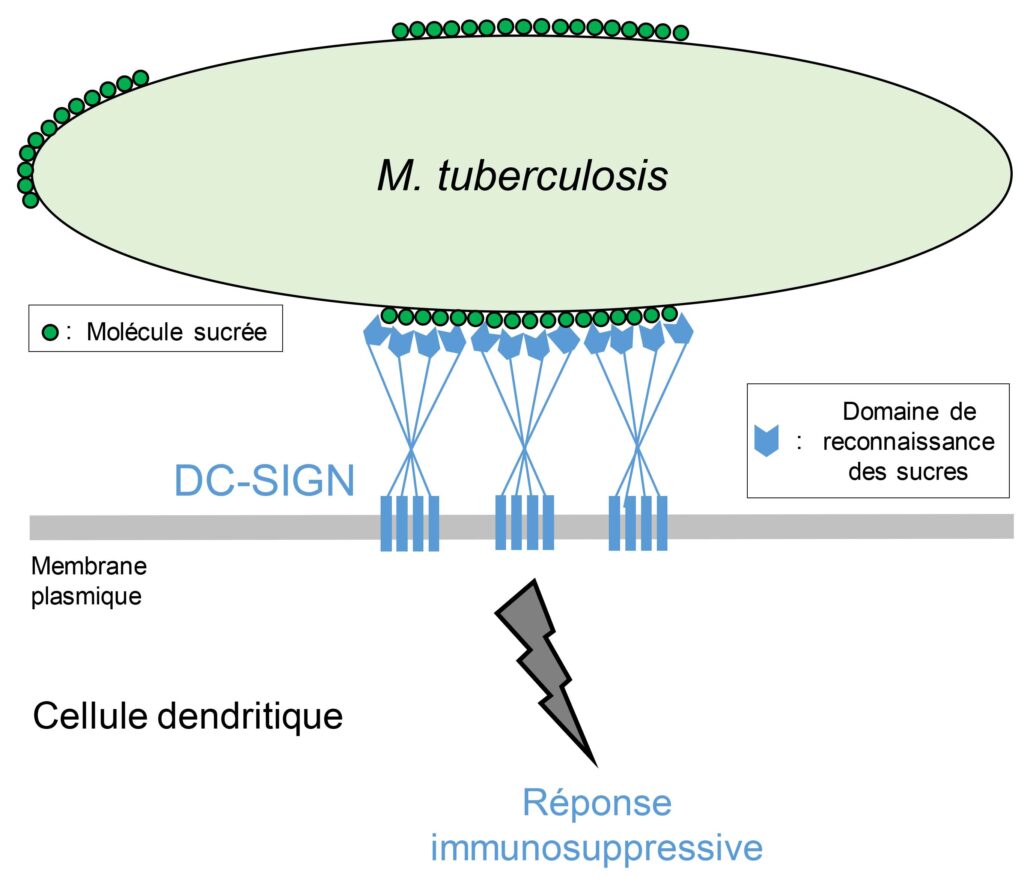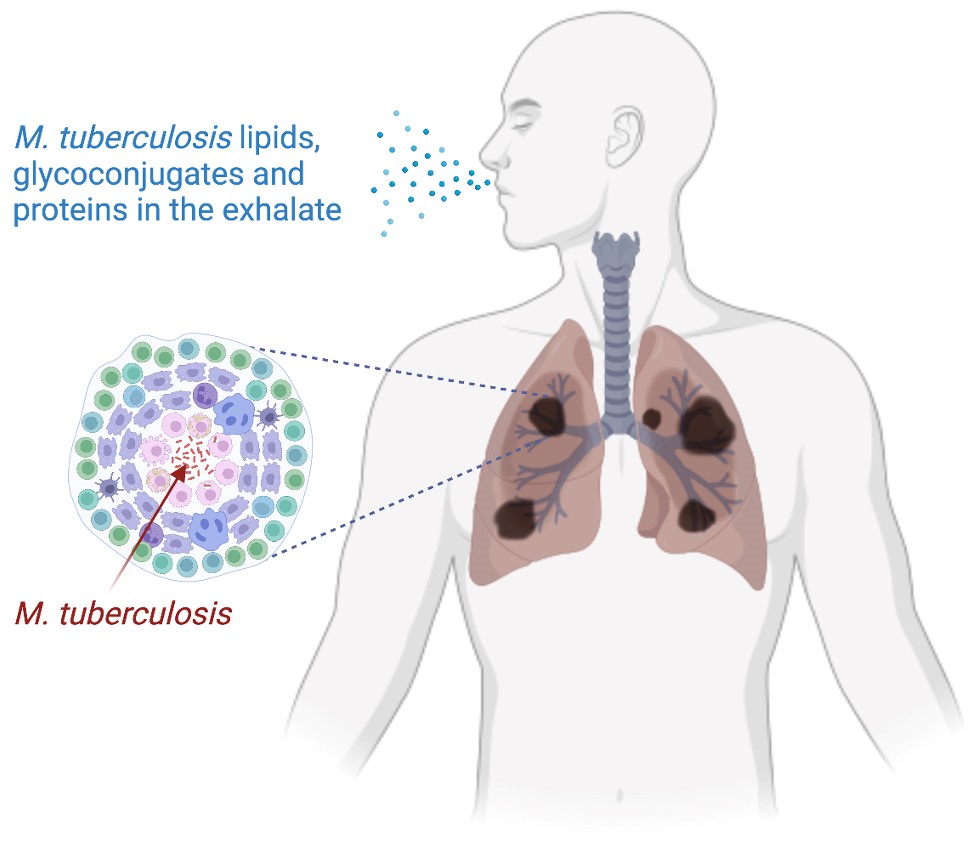Press Releases
May 2023: How the organization of carbohydrate molecules on the surface of its envelope allows Mycobacterium tuberculosis to trick the immune system

The surface of the envelope of Mycobacterium tuberculosis is covered with carbohydrate molecules that are organized in nano-domains constituting platforms of strong interaction with the DC-SIGN receptor, itself organized in clusters at the membrane of immune cells. The recognition by DC-SIGN induces an immunosuppressive response that promotes the multiplication of the pathogen within the infected organism. Copyright: Jérôme Nigou Thumbnail Copyright: Albertus Viljoen et Yves Dufrêne
In this study, the scientists showed, notably through the use of a molecular imaging technique with nanometric resolution, that the carbohydrate molecules on the surface of the M. tuberculosis complex species, contrary to species of the same bacterial genus, are organized in large domains that constitute platforms of strong interaction with the DC-SIGN receptor, itself organized in clusters.
These results constitute a conceptual advance in the understanding of the functioning of receptors specialized in the recognition of carbohydrate molecules, demonstrating that the organization of ligands at the surface of microorganisms is a key parameter. Moreover, they change our perception of the surface of bacterial envelopes, by suggesting the presence of functional domains. Finally, they open the way to the development of new anti-tuberculosis approaches using immunomodulation.
Source
Nanoscale clustering of mycobacterial ligands and DC-SIGN host receptors are key determinants for pathogen recognition. Albertus Viljoen†, Alain Vercellone†, Myriam Chimen, Gérald Gaibelet, Serge Mazères, Jérôme Nigou* and Yves F. Dufrêne*. Science Advances, 9(20):eadf9498. DOI: 10.1126/sciadv.adf9498. † co-first authors; * co-senior authors- Access the article
Researcher contact
Jérôme Nigou | Jerome.Nigou@ipbs.fr | +33 (0)5 61 17 55 54 | @NigouJ
Press contact
Francoise Viala | communication@ipbs.fr | +33 (0)6 01 26 52 59
Read the Press release (in French): here
December 2022: Towards a point-of-care diagnosis of tuberculosis, directly from the analysis of patients’ exhaled air
The World Health Organization (WHO) estimates that there are 10 million new cases of tuberculosis per year, 12% of which are children. However, 1/3 of these cases remain undiagnosed, mainly because of limitations of the tools currently available. The scientists’ work shows that the air exhaled by tuberculosis patients contains traces of the presence of the bacteria responsible for tuberculosis and that its analysis would allow a much more sensitive, rapid and easy diagnosis of the disease. The study was published on December 14, 2022 in the journal Nature Communications.
WHO’s goal is to reduce TB mortality and incidence by 90% and 80% respectively by 2030 compared to 2015 levels. This cannot be achieved without the development of much more effective diagnostic tools. TB diagnosis is currently based on clinical and radiographic examinations, coupled with bacteriological analysis of sputum where the presence of Mycobacterium tuberculosis, the bacterium responsible for the disease, is searched for by microscopic analysis, culture and/or gene amplification. However, sputum analysis has a low sensitivity in children and in individuals with low sputum counts, such as HIV co-infected patients.

Tuberculosis patients exhale large quantities of Mycobacterium tuberculosis molecules, including lipids, glycoconjugates and proteins, that can be assayed for disease detection. (Created with BioRender.com) © Jérome Nigou, Olivier Neyrolles
In this study, scientists evaluated the diagnostic potential of a poorly explored biological sample, the exhaled breath condensate. This sample, which corresponds to the liquid phase of exhaled air sampled by cooling, has many advantages in the context of TB diagnosis. Indeed, it is constituted by the aerosolization of the liquid covering the respiratory epithelium; its composition thus varies according to the pathological state of the lung. Moreover, its collection is easy, non-invasive, and does not require specialized personnel. Here, scientists have been able to detect in the exhaled breath condensate collected from TB patients the presence of molecules (glycoconjuugates, lipids and proteins) produced by M. tuberculosis, allowing to differentiate these patients from healthy individuals or those with other respiratory infections. Interestingly, this approach, which can be implemented in the short term directly at point-of-care, allows the detection of TB patients for whom the bacteriological analysis of sputum is negative.
The results of this pilot study have already attracted the attention of several national and international organizations and are being validated on larger cohorts of patients in different regions of the world.
Source
A Mycobacterium tuberculosis fingerprint in human breath allows tuberculosis detection” Sergio Fabián Mosquera-Restrepo, Sophie Zuberogoïtia, Lucie Gouxette, Emilie Layre, Martine Gilleron, Alexandre Stella, David Rengel, Odile Burlet-Schiltz, Ana Cecilia Caro, Luis F. Garcia, César Segura, Carlos Alberto Peláez Jaramillo, Mauricio Rojas*, Jérôme Nigou* Nature Communications December 14, 2022 – Access the article
Researcher contact
Jérôme Nigou | Jerome.Nigou@ipbs.fr | +33 (0)5 61 17 55 54 | @NigouJ
Press contact
Francoise Viala | communication@ipbs.fr | +33 (0)6 01 26 52 59
Read the Press release (in French): here
Listen to the podcast on France Culture (in French): here
Read comments in Le Monde: here
October 2017: Mycobacterium tuberculosis plays hide-and-seek with the immune system
To secure their colonization and survival, pathogens have evolved tactics to undermine host immune responses. Better understanding pathogen invasion strategies is key to develop appropriate preventive or therapeutic tools. Scientists from the team “Immunomodulation by Mycobacterial Lipids and Glycoconjugates” at the Institute of Pharmacology and Structural Biology (IPBS – CNRS/Université Toulouse III – Paul Sabatier) have uncovered a molecular mechanism by which the tuberculosis bacillus escapes detection by the innate immune system. This study is published in the Proceedings of the National Academy of Sciences of the USA, on October 2 2017.
Mycobacterium tuberculosis, the causative agent of human tuberculosis, is a bacterial pathogen that has adapted to subvert the function of macrophages, whose one of the roles is to recognize and kill invading microorganisms. In the present study, the scientists used a library of M. tuberculosis mutants to infect macrophages and decipher molecular mechanisms by which the pathogen modulates the function of these immune cells. They found that M. tuberculosis produces cell envelope glycolipids that are antagonists of a macrophage receptor, named TLR2, which is dedicated to the recognition of pathogens, thereby preventing its efficient recognition by the immune system.
Source
Landry Blanc, Martine Gilleron, Jacques Prandi, Ok-ryul Song, Mi-Seon Jang, Brigitte Gicquel, Daniel Drocourt, Olivier Neyrolles, Priscille Brodin, Gérard Tiraby, Alain Vercellone & Jérôme Nigou (2017) Mycobacterium tuberculosis inhibits human innate immune responses via the production of TLR2 antagonist glycolipids. PNAS, Published ahead of print October 2, 2017 doi:10.1073/pnas.1707840114. Access the article
This work was performed in collaboration with the Centre d’Infection et d’Immunité de Lille (CIIL), the Pasteur Institutes from Paris and Korea, and the biotech company InvivoGen (Toulouse).
Researcher contact
Contact Jérôme Nigou (jerome.nigou@ipbs.fr)
Read the Press release (in French): here
February 2017: Rational design of adjuvants targeting the C-type lectin Mincle
Vaccination is a highly effective method of preventing infectious diseases. However, adjuvants are needed to enhance the immunogenicity of vaccine antigens. For many years, the development of adjuvants has been an empirical process. Scientists from the team “Immunomodulation by Mycobacterial Lipids and Glycoconjugates” at the Institute of Pharmacology and Structural Biology show that new generation adjuvants can be designed on a rational basis. This study is published in the Proceedings of the National Academy of Sciences of the USA, on 21 Feb 2017.
Vaccines are mainly used to fight infectious diseases but they can also help to treat cancer. Historically, vaccines have been made with live attenuated or dead pathogens. For many pathogens, however, such vaccines have not been successfully developed. Moreover, they can be associated to side effects. Current efforts aim at the development of subunit vaccines that induce a well-defined immune response against specific antigens, from pathogens (virus, bacteria) as well as from tumors.
However, vaccine antigens are often poorly immunogenic and require additional components, termed adjuvants, to help stimulate protective immunity. Most of the adjuvants in use have been developed empirically without a clear understanding of their mechanisms of action. Adjuvants inducing a strong humoral immunity, which protects against extracellular pathogens, are available. But, adjuvants directing the development of robust cellular immune responses, required to fight against intracellular pathogens or tumors, are still needed. Recently, the C-type lectin receptor Mincle was found to elicit such responses on the recognition of microbial glycolipids, thereby providing a basis for the rational design of new adjuvants. In the present study, the scientists used a multidisciplinary approach, combining chemical synthesis, cell biology, and molecular modeling to decipher the molecular bases of ligand recognition by the receptor. This led them to synthesize new compounds inducing stronger immune responses, while being less toxic, than the currently available Mincle ligands, and that represent new powerful adjuvant molecules.
This work was performed in collaboration with the biotech company Invivogen (Toulouse), the “Laboratoire d’Ingénierie des Systèmes Biologiques et des Procédés” (Toulouse) and the “Centro Nacional de Investigaciones Cardiovasculares Carlos III (Madrid).
Source
Decout, A., Silva-Gomes, S., Drocourt, D., Barbe, S., André, I., Cueto, F.J., Lioux, T., Sancho, D., Pérouzel, E., Vercellone, A., Prandi, J., Gilleron, M., Tiraby, G. & Nigou, J. (2017) Rational design of adjuvants targeting the C-type lectin Mincle. PNAS, doi: 10.1073/pnas.1612421114. Access the article
Researcher contact :
Jérôme Nigou | Jerome.Nigou@ipbs.fr | +33 (0)5 61 17 55 54 | @NigouJ
Read the Press release (in French): here
January 2014: A group in Toulouse is awarded a prestigious grant to develop a new vaccine against tuberculosis
Our group has just received a funding from the Brigham & Women’s Hospital, as part of a grant from the Grand Challenges TB Vaccine Accelerator, an initiative of the Bill & Melinda Gates Foundation. This international project involving two american groups, Boston and Atlanta, and three european groups, Salisbury (UK), Groningen (Netherlands) and Toulouse, will explore a very original track to develop a new vaccine against tuberculosis and will be funded to the tune of more than $ 3 million by the foundation. In contrast to classical approaches, it aims at developing a vaccine, which is not based on proteins but on bacterial lipids.
May 2013: Mannodendrimers : anti-inflammatory drugs of tomorrow ?
The discovery of an immune escape strategy used by Mycobacterium tuberculosis, the etiological agent of human tuberculosis, has led the team “Immunochemistry and mycobacterial glycoconjugates” from Institut de Pharmacologie et de Biologie Structurale (IPBS, CNRS/Université Toulouse III – Paul Sabatier) to design a novel type of powerful anti-inflammatory molecules. Published in PNAS on May 13, this work performed in collaboration with the Laboratoire de Chimie de Coordination (LCC, CNRS/UPS/INPT) and Laboratoire de Toxicologie Alimentaire (TOXALIM, INRA/UPS/INPT) opens avenues for the development of new therapeutic strategies to combat inflammatory diseases.
Read the Press release (in French): here
April 2013: Bacterial protein-O-mannosylating enzyme is crucial for virulence of Mycobacterium tuberculosis
A posttranslational protein O-mannosylation process resembling that found in fungi and animals has been reported in the major human pathogen Mycobacterium tuberculosis (Mtb) and related actinobacteria. However, the role and incidence of this process, which is essential in eukaryotes, have never been explored in Mtb.
Read the Press release (in French): here

